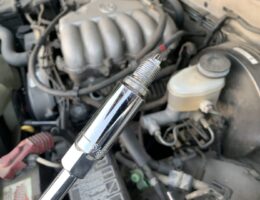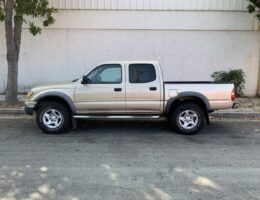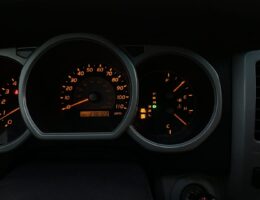Changing the oil on a car can vary in difficulty depending on the vehicle you’re working on. Unfortunately on a 1st generation Toyota Tacoma with the 5VZ-FE (3.4L V6) engine, it is more on the difficult side mainly due to access issues with the oil filter. The draining and refilling of the oil on this vehicle is pretty straightforward, but the accessing, removing, and draining of the oil filter can be frustrating.
To properly and completely drain and fill the the coolant on our 1st generation Toyota Tacoma, it is necessary to replace the coolant in both the radiator and the engine. This requires emptying out the coolant in two locations and refilling accordingly. The 1st generation Tacoma has a variety of configurations that can make the coolant capacity slightly differ from one model to the next.
Not all 1st generation Toyota Tacomas (1995-2004) have keyless entry. For model years 2001-2004, a factory alarm or keyless entry may be equipped with the vehicle. In these cases, a keyless entry remote should be included with the vehicle. If you purchase a new OEM remote and have a dealership program it for you, they might charge you over $100 to do so. Alternatively, you can purchase an OEM remote or a more affordable aftermarket remote, and program it yourself.
Lubricating the driveshaft (a.k.a. propeller shaft) is a key maintenance item on the 4th generation Toyota 4Runner that every owner should be doing. Armed with a grease gun and appropriate grease, it is easy to grease up the driveshaft and keep your driveline working properly. There is a bit of variability in information related to how often you should be greasing your driveshaft, as well as what type of grease you should be using on the various components of the propeller shafts. Once you navigate through the confusion around the the maintenance interval and the grease type, the maintenance itself is quite easy and ensures you keep your driveline in tip-top shape.
The 1st generation Toyota Tacoma with the 3.4L V6 (5VZ-FE engine) has six twin ground electrode spark plugs. Toyota recommends that these spark plugs be replaced every 30,000 miles, however there are many accounts of 5VZ-FE owners who have driven on the same set of spark plugs for double and triple that mileage. I personally wouldn’t let it go to 90,000 miles, but I also wouldn’t necessarily follow the 30k-mile change interval either. My parents’ Tacoma is about 15 years old with only 30k miles on the clock, so we decided to replace the spark plugs more so due to the age rather than the mileage interval.
The 1st generation Toyota Tacoma PreRunner has a RWD drivetrain that uses a rear differential to transfer power from the transmission to the rear wheels. As opposed to a 4WD vehicle which employs the use of a front differential, transfer case, and rear differential to transfer power to all four wheels, a PreRunner with RWD only has a rear differential to service. With regular driving, Toyota suggests inspecting the rear differential fluid every 15,000 miles. My Haynes Manual recommends to replace the differential fluid every 30,000 miles. On my parents’ Tacoma, they don’t do any towing. Their truck sits at a bit over 30k miles so I went ahead and did the first rear differential fluid change on this truck.
Inspection and replacement of the engine air filter on the 1st Gen Toyota Tacoma is probably one of the easiest jobs you’ll encounter. It literally takes 1 minute to inspect and maybe 2 minutes to replace. With that said, there’s no good reason for not following Toyota’s scheduled maintenance interval for inspecting and replacing the engine air filter.
When my parents bought this 2004 Toyota Tacoma, I didn’t think much of it. Looking back now, I can appreciate that this is one of the better equipped Tacomas of the first generation. It’s the last year of the 1st gen Tacoma(’95-’04), has the 3.4L V6 5VZ-FE engine, and has the PreRunner trim package. Probably the only thing missing that I would want on this truck would be 4WD. If I were to get a midsize pickup truck, I would love to have one of these (believe me, I tried buying it off my parents but they still drive it).
It’s a common issue on the 4th generation Toyota 4Runner to encounter the ‘VSC TRAC’ and ‘VSC OFF’ warning lights come on randomly and stay on. These lights may come on whenever you have an engine trouble code, which will be apparent when the engine light also comes on at the same time. However, if you are experiencing only the ‘VSC TRAC’ and ‘VSC OFF’ lights on without the check engine light on, then there might be a quick fix to getting rid of those lights.









